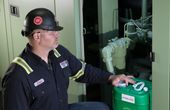Analog Devices Voyager 3 Wireless Vibration Monitoring Platform
MEMS-based wireless vibration monitoring kit for accelerating asset monitoring.
General
| Product Type | Measurement & Testing Equipment |
| Applications | Industrial Automation, Data Logging & Monitoring, Enviromental Monitoring, IoT & Smart Systems |
| Key Features | High-Performance Vibration Sensing, Low-Power Signal Processing and Transmission, Rapid Deployment and Evaluation |
Technical Specifications
| Product | Evaluation Kit |
| Type | Sensing - Motion, Vibration, Shock |
| Sensor Type | 3-Axis MEMS Accelerometer |
| Bandwidth | Up to 2.6 kHz |
| ADC | 16-bit, Low Power |
| Wireless Technology | SmartMESH |
| Applications | Predictive Maintenance, Condition Monitoring, Structural Health Monitoring, and Prototype Testing |
Overview
The Voyager 3 by Analog Devices is a comprehensive solution designed for rapid deployment in MEMS-accelerometer-based vibration monitoring systems. This platform integrates mechanical, hardware, firmware, and PC software components to facilitate comprehensive vibration analysis. At its core is the ADXL356 three-axis accelerometer, which captures vibration data. This data is digitized using three AD7685 16-bit ADCs and then processed by the ADuCM4050 low-power microcontroller. Data is presented in both time and frequency domains, along with summary statistics. Multiple modules can form a wireless mesh network for broader monitoring. The Voyager 3 platform, available in two evaluation kits, is ideal for Condition Based Monitoring (CbM) applications, helping to predict equipment failures and optimize maintenance.
Voyager 3 Wireless Vibration Monitoring Platform Features
The Voyager 3 platform offers a robust suite of features designed for efficient and accurate vibration monitoring. From advanced sensor technology to versatile deployment options, this platform empowers users to optimize equipment performance and prevent unexpected downtime. Let’s explore its notable features:
High-Performance Vibration Sensing
The Voyager 3 Wireless Vibration Monitoring Platform incorporates a high-performance three-axis MEMS accelerometer, the ADXL356. This sensor is engineered for low power consumption and noise reduction, enabling precise vibration measurement up to 2.6kHz. Its ability to capture data across three axes ensures comprehensive vibration analysis, enabling the detection of anomalies across multiple directions.
Low-Power Signal Processing and Transmission
The platform's signal processing is handled by the ADuCM4050 low-power microcontroller, which efficiently processes data from the three AD7685 16-bit ADCs. The processed data, including time-domain and FFT information, is transmitted wirelessly through the robust and energy-efficient SmartMESH IP mote. This wireless technology is optimized for industrial environments, ensuring reliable data transmission.
Rapid Deployment and Evaluation
The Voyager 3 features a versatile mechanical mounting system compatible with a ¼-28 stud, allowing for direct attachment to machinery or fixtures. This streamlined approach accelerates system setup and evaluation in real-world conditions. The platform's integrated hardware, firmware, and PC software facilitate a smooth deployment and assessment process. Users can effectively evaluate ADI's MEMS sensor and SmartMESH technology, expediting the development of their asset monitoring solutions.
Comprehensive System Integration
The Voyager 3 platform supports integration into larger Condition-Based Monitoring (CBM) systems through its wireless mesh network capability. Multiple modules can collaborate to provide a holistic view of asset health by aggregating data from various sensor nodes. The platform's PC software offers visualization and analysis tools, including time-domain data, FFT data, and summary statistics, for effective equipment condition monitoring. To accommodate specific monitoring needs, users can customize the system using the provided Python code for the GUI and C firmware for the module.
Applications
The Voyager 3 Wireless Vibration Monitoring Platform finds utility in various industrial sectors. Its primary applications include predictive maintenance in rotating machinery, where it detects anomalies in vibration patterns indicative of impending failures. Additionally, it's valuable in structural health monitoring to assess the integrity of bridges, buildings, and turbines. In manufacturing, it optimizes equipment performance by identifying vibration-related issues. Moreover, the platform aids in noise, vibration, and harshness (NVH) analysis for automotive and aerospace industries to enhance ride comfort and reduce acoustic emissions.
Where to find it

Mouser Electronics
Mouser Electronics is a worldwide leading authorized distributor of semiconductors and electronic components.










